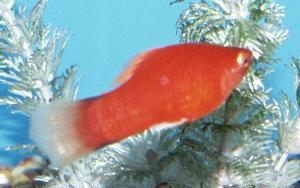Platy - Red
Scientific Name: Xiphophorus maculatus
Fri, 4th July, 2025 - 6:39 am GMT
Sponsor Ads:

Alternative Name
Scientific Name: Xiphophorus maculatusBasic Info
At maturity, the Platy will reach a size of two to three inches. They have stocky, fat, stubby bodies with a rounded caudal fin. Their bodies are usually a mixture of red, yellow, gold, black and blue. Younger Platys are usually brighter.
Health
Platys are not a picky fish. Most of their time is spent either breeding or looking for food. They will eat just about anything, but prefer foods such as spinach, zucchini, peas, lettuce, fish, flood worms, glass worms, brine shrimp and tubifex worms. They will eat flake and freeze dried foods as well. Their water should kept at tropical temperatures between 70 and 86 degrees Fahrenheit and the pH level of the water should be slightly alkaline, between seven and eight. The water should be soft and a teaspoon of Epsom salts can be added to every five gallons of water they inhabit. Breeding The Platy is very easy to breed. It is said, to get them to breed, just add water. Platys are livebearers. The male will have a short gonopodium where the anal fin should be. Females will have a triangular anal fin. Platys will give birth to 20 to 40 fry when spawning. It is reported that one should keep plenty of plants for babies to hide in or the parents may eat them.Habitat
Fresh water fishBehavior
The Platy is prized among aquarists because they are small, hardy, active, peaceful and beautiful. They make great fish for both beginning and experience aquarists alike. They also make great feeder fish, due to their ease of breeding and low cost. The Platy is a great fish for communities. It can survive in most conditions and will not bother other fish. If kept in groups, Platys will form schools. They are very active, however and could agitate less active fish, such as Angel Fish. Platys can be kept in small tanks, but prefer large spaces, with plenty of room to swim. Their tank should be moderately decorated with plants and rocks. The Platy will not bother live plants.Origin
MexicoHistory
Platys are found in the Rio Papaloapan, in southern Mexico.Common Foods
N/ASponsor Ads:
Thoughts on Programming, Number 40: Never go to sea with two chronometers; take one or three. -Anonymous
Platy - Red
Coded by: BGID® | ALL RIGHTS RESERVED Copyright © 2000-2025
Disclaimer | Privacy | Report Errors / Contact | Credits

 Why haven't we as a collective earth met with aliens yet?
Why haven't we as a collective earth met with aliens yet?  World EcoSystem - Biodiversity Changes - Who is on board and who isn
World EcoSystem - Biodiversity Changes - Who is on board and who isn  Homosexual behavior stems from the mind or genetics?
Homosexual behavior stems from the mind or genetics?  The Best Text Adventure You Will Ever Play! The official site:
The Best Text Adventure You Will Ever Play! The official site:  Mouthwash - Mouthrinse - Mouth Sores - Healing Infections - Gingivitis
Mouthwash - Mouthrinse - Mouth Sores - Healing Infections - Gingivitis  Treatment for Depression
Treatment for Depression  Ultra radical and violent Islamist group that even rivals Al Qaeda
Ultra radical and violent Islamist group that even rivals Al Qaeda  An idea to have teachers who want to carry guns to school undergo some level of police training will be left up to local school districts and police departments.
An idea to have teachers who want to carry guns to school undergo some level of police training will be left up to local school districts and police departments.